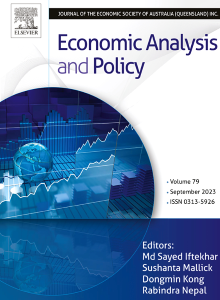Green structural monetary policy and firms’ Asymmetric carbon emission reduction: Evidence from China
IF 7.9
2区 经济学
Q1 ECONOMICS
引用次数: 0
Abstract
Using data from Chinese listed companies, this paper examines the impact of green structural monetary policy on corporate carbon emissions and its underlying mechanisms from two perspectives: bank credit reallocation and corporate emission reduction strategies. The study finds that the impact of green structural monetary policy on corporate carbon emissions is asymmetric. While the policy significantly reduces carbon emissions for clean enterprises, its suppressive effect on emissions from heavily polluting enterprises is relatively limited. The mechanism test results indicate that in terms of bank credit decisions, the green structural credit policy restricts the financing scale of heavily polluting enterprises, increases their financing costs, and simultaneously provides credit incentives for clean enterprises. In terms of corporate carbon reduction strategies, the asymmetry of policy effects partly stems from differences in how policies influence corporate strategic behaviors. Heavily polluting firms tend to adopt “low-cost strategies,” characterized by end-of-pipe treatment investments and strategic green innovations. In contrast, clean firms are more inclined to pursue “competitive advantage strategies,” emphasizing proactive investment in prevention and substantive green innovations. Further analysis reveals that the asymmetric emissions-reduction effects of the policy are jointly influenced by external and internal factors.
绿色结构性货币政策与企业碳减排的不对称:来自中国的证据
本文利用中国上市公司的数据,从银行信贷再配置和企业减排策略两个角度考察了绿色结构性货币政策对企业碳排放的影响及其机制。研究发现,绿色结构性货币政策对企业碳排放的影响是不对称的。虽然该政策显著减少了清洁企业的碳排放,但对重污染企业的碳排放抑制作用相对有限。机制检验结果表明,在银行信贷决策方面,绿色结构性信贷政策限制了重污染企业的融资规模,增加了重污染企业的融资成本,同时为清洁企业提供了信贷激励。在企业碳减排战略方面,政策效应的不对称部分源于政策对企业战略行为影响方式的差异。重污染企业倾向于采用“低成本战略”,其特点是终端处理投资和战略性绿色创新。相比之下,清洁企业更倾向于追求“竞争优势战略”,强调在预防和实质性绿色创新方面的主动投资。进一步分析表明,该政策的非对称减排效果是由外部因素和内部因素共同影响的。
本文章由计算机程序翻译,如有差异,请以英文原文为准。
求助全文
约1分钟内获得全文
求助全文
来源期刊

Economic Analysis and Policy
ECONOMICS-
CiteScore
9.80
自引率
9.20%
发文量
231
审稿时长
93 days
期刊介绍:
Economic Analysis and Policy (established 1970) publishes articles from all branches of economics with a particular focus on research, theoretical and applied, which has strong policy relevance. The journal also publishes survey articles and empirical replications on key policy issues. Authors are expected to highlight the main insights in a non-technical introduction and in the conclusion.
 求助内容:
求助内容: 应助结果提醒方式:
应助结果提醒方式:


